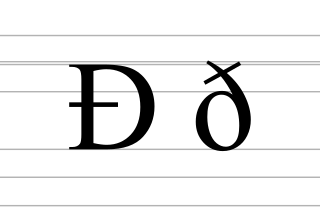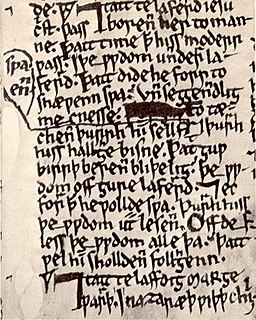 W
WMiddle English was a form of the English language spoken after the Norman conquest (1066) until the late 15th century. English underwent distinct variations and developments following the Old English period. Scholarly opinion varies, but the Oxford English Dictionary specifies the period when Middle English was spoken as being from 1150 to 1500. This stage of the development of the English language roughly followed the High to the Late Middle Ages.
 W
WThe Carolingian G or French G (𝗴) is one of two historical variants of the letter G that were in use in the Middle English alphabet.. The Carolingian G is named for the Carolingian minuscule script, an exemplar of its use.
 W
WThe Cloud of Unknowing is an anonymous work of Christian mysticism written in Middle English in the latter half of the 14th century. The text is a spiritual guide on contemplative prayer in the late Middle Ages. The underlying message of this work suggests that the way to know God is to abandon consideration of God's particular activities and attributes, and be courageous enough to surrender one's mind and ego to the realm of "unknowing", at which point one may begin to glimpse the nature of God.
 W
WEth is a letter used in Old English, Middle English, Icelandic, Faroese, and Elfdalian. It was also used in Scandinavia during the Middle Ages but was subsequently replaced with dh and later d. It is often transliterated as d. The lowercase version has been adopted to represent a voiced dental fricative in the International Phonetic Alphabet.
 W
WThe Forth and Bargy dialect, also known as Yola, is an extinct Anglic language once spoken in the baronies of Forth and Bargy in County Wexford, Ireland. It is thought to have evolved from Middle English, which was brought to Ireland during the Norman invasion, beginning in 1169. As such, it was similar to the Fingallian dialect of the Fingal area. Both became extinct in the 19th century, when they were replaced by modern Hiberno-English. The name "Yola" means "old" in the dialect.
 W
WThe Kildare Poems or Kildare Lyrics are a group of sixteen poems written in an Irish dialect of Middle English and dated to the mid-14th century. Together with a second, shorter set of poems in the so-called Loscombe Manuscript, they constitute the first and most important linguistic document of the early development of Irish English in the centuries after the Anglo-Norman invasion of Ireland. The sixteen poems have religious and satirical contents. They are preserved in a single manuscript, where they are scattered between a number of Latin and Old French texts. The conventional modern designation "Kildare poems" refers both to the town of Kildare in Ireland, which has been proposed as their likely place of origin, and to the name of the author of at least one of the poems, who calls himself "Michael (of) Kildare". The poems have been edited by W. Heuser (1904) and A. Lucas (1995).
 W
WThe Ormulum or Orrmulum is a twelfth-century work of biblical exegesis, written by a monk named Orm and consisting of just under 19,000 lines of early Middle English verse. Because of the unique phonetic orthography adopted by its author, the work preserves many details of English pronunciation existing at a time when the language was in flux after the Norman conquest of England. Consequently, it is invaluable to philologists and historical linguists in tracing the development of the language.
 W
WMiddle English was a form of the English language spoken after the Norman conquest (1066) until the late 15th century. English underwent distinct variations and developments following the Old English period. Scholarly opinion varies, but the Oxford English Dictionary specifies the period when Middle English was spoken as being from 1150 to 1500. This stage of the development of the English language roughly followed the High to the Late Middle Ages.
 W
WThe Peterborough Chronicle, one of the Anglo-Saxon Chronicles, contains unique information about the history of England after the Norman Conquest. According to philologist J.A.W. Bennett, it is the only prose history in English between the Conquest and the later 14th century.
 W
WThorn or þorn is a letter in the Old English, Gothic, Old Norse, Old Swedish, and modern Icelandic alphabets, as well as some dialects of Middle English. It was also used in medieval Scandinavia, but was later replaced with the digraph th, except in Iceland, where it survives. The letter originated from the rune ᚦ in the Elder Fuþark and was called thorn in the Anglo-Saxon and thorn or thurs in the Scandinavian rune poems. It is similar in appearance to the archaic Greek letter sho (ϸ), although the two are historically unrelated.
 W
WThe letter yogh (ȝogh) was used in Middle English and Older Scots, representing y and various velar phonemes. It was derived from the Insular form of the letter g.